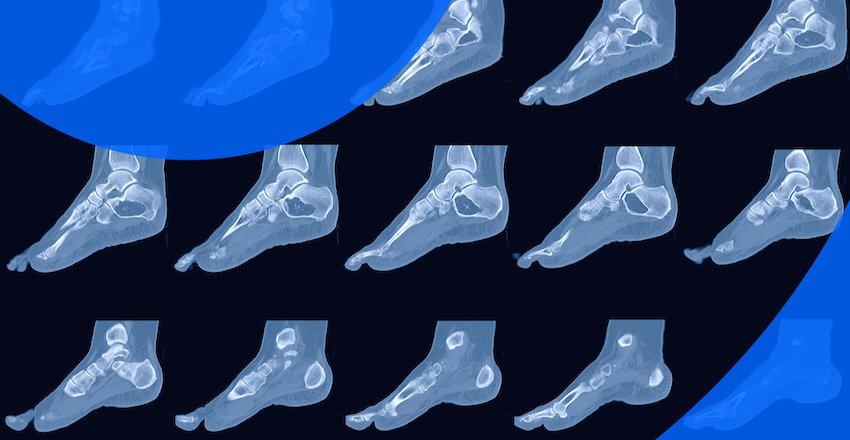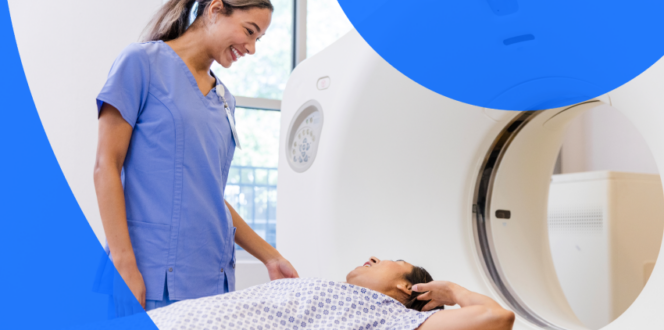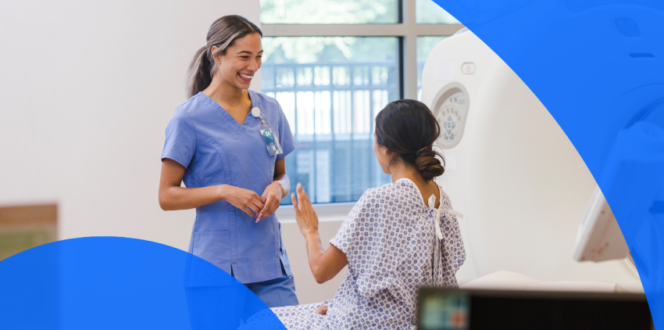How Quickly Can I See My CT Scan Results Online?

Wondering how quickly you can see your CT scan results online? With PocketHealth, your health records are at your fingertips.
Knowing how to access your CT scan results can give you valuable insights into your health and allow you to have more informative conversations when discussing the results with your referring practitioner. Having access to your medical records is also the law according to the Health Insurance Portability and Accountability Act of 1996 (HIPAA) in the U.S. and the Privacy Act in Canada, including Ontario’s Personal Health Information Protection Act (PHIPA) at the provincial level.
Access to high-quality images alongside the radiologist’s report for your CT scan gives you the freedom to take control of your health and share your health information and results with any care provider you choose, making it easy to get a second opinion and compare medical documents over time. By accessing your records through PocketHealth you can securely store, understand and share all your medical images and reports.
Knowing what to expect during and after your CT scan can help you understand:
- How quickly you can access your CT scan results
- What terms are in your CT scan report
- How to share your CT scan results with care providers and family
- Who has access to those results
When can you expect your CT scan results to be ready?
You’re not alone if you feel anxious waiting for your CT scan results: over 50% of patients feel anxious or stressed waiting for medical test results, according to a 2023 Leger survey. Having secure, online access to your CT scan results as soon as they are available can help reduce stress or “scanxiety”—and 68% of patients want access to effectively advocate for their health.
Reviewing your CT scan results promptly can help alleviate some of the anxiety you may feel while waiting for your follow-up appointment. The imaging clinic or hospital will often send your CT scan results to your referring physician within a week of your scan, but that timing can change depending on different factors impacting your specific case.
Circumstances that might change how quickly you receive your CT scan results include:
- The urgency of your case. In some instances, CT scan results can be expedited and sent to your physician sooner than a week.
- The complexity of your scan. CT scans that cover a larger area or require an in-depth assessment may take the radiologist longer to review.
- Whether the radiologist requires more information. Your physician may send you for more imaging exams or repeated imaging, under the advice of the radiologist who needs more information to properly assess your case.
- Comparing different CT scan images and reports over time. The radiologist who reviews your imaging will compare it to previous CT scans or other medical imaging you’ve done in the past.
- Transferring your CT scan results to your referring practitioner. Diagnostic imaging, including CT scans, is often transferred to your primary care provider electronically or using CDs. In some cases, technical issues can cause portions of your results to arrive separately from each other.
Your CT scan results may be available online through your referring physician’s patient portal or the imaging clinic. Still, these sharing methods don’t always include the images, or, if images are included, they may not be in diagnostic quality. Diagnostic-quality imaging is important because it allows you to view your results just as your physician does and enables you to easily get a second opinion.
5 benefits of having access to your CT scan results online
It’s easy to feel in the dark about your health while waiting for your physician to share your CT scan results. PocketHealth helps you gain some control over your healthcare journey by giving you fast, easy and secure access to your medical reports, as soon as they are available.
Here are 5 ways PocketHealth helps ensure you are a partner, not a passenger, in your own care:
- You get faster, easier access. PocketHealth enables you to see your medical images and reports the moment they’re released by the radiologist and view them from any device. No need to anxiously await your follow-up doctor’s appointment.
- You can share your results. If you want to keep your entire healthcare team up to date or need a second opinion, you can email, print or fax a secure access page to another practitioner, from your account. And that practitioner doesn’t need to be on PocketHealth to view your CT scan images in full, diagnostic quality.
- You can ask more informed questions. It can be difficult to decipher the complex medical terms in your CT scan report. With PocketHealth Report Reader, you can easily understand what those terms mean, allowing you to have more informative conversations with your practitioner during a follow-up appointment.
- You’ll never miss a follow-up. A study from the American College of Radiology reports that 60% of medical imaging recommendations are never followed up on. With PocketHealth you’ll know when a follow-up is needed, allowing you to be on top of the recommended next steps.
- You own your records. All your health records are secured with bank-level encryption technology and will always be centralized in one place for you to access and share. PocketHealth secure storage helps you avoid requesting records in writing, which can take 30-60 days and may require a fee.
With access to your CT scan imaging and report, PocketHealth enables you to arrive at your next appointment feeling confident, informed and ready to participate in your own care.
How can you read your CT scan report online?
The radiologist who reviews your CT scan results will create a report about what they see and send both the CT scan images and report to your referring physician. The images generated during your CT scan will show the radiologist whether any irregularities were detected, and the radiologist will describe these and give their input about what they see on the report they create for your physician.
A CT scan uses X-ray technology to create cross-sectional images or slices of the body. CT scans take images from different angles and combine them into one image for a comprehensive view. Your CT scan images may be taken in 3 different ways to capture a complete 360-degree picture of you:
- Coronal. This is a front-view picture that presents a mirror image of your body. For example, in a coronal view of a CT scan, the left side of the body will be on the right side of the image, and vice versa.
- Sagittal. A sagittal or side-view image is a cross-sectional capture taken from the side-profile view of the body.
- Axial. An axial image is a cross-sectional view that will also present as a mirror image. In an axial view of a CT scan, images are taken from feet to head or bottom to top.
Coronal, sagittal and axial image sequences offer the radiologist different views to allow them to see all areas of your body, but these sequences also give the radiologist more information about the tissue and structures they see.
Understanding the Hounsfield scale
CT scan images are reviewed using a numbering scale called the Hounsfield scale. Denser areas of the body—such as bone—appear white, while less dense areas appear darker. Intravenous contrasting liquid may be used to better show areas of increased blood flow, like tumors.
Hounsfield numbers are applied to the scan images depending on the density of the structures or tissue captured. For example:
- Water is given a Hounsfield number of 0 and is considered neutral.
- Dense structures like bone may be given a number of 700.
- Lung tissue is lucent, the opposite of dense. It may be given a number of -500.
Next steps after a CT scan
It is important that you attend any scheduled follow-up appointments with your physician to discuss the results of your CT scan, even if you have access to your own CT scan images and report.
Your physician can give you essential insight into your results because they will be able to view your CT scan images within the context of any other tests or appointments you’ve had in the past. Your physician will also discuss any next steps with you and give you all the information you need to decide what’s next.
How long does it take to get CT scan results?
If you have a CT scan performed as an outpatient, a radiologist will read the results, interpret the images and send the report to your referring physician. This process can take up to a week. Once the report is received, your doctor will set up a follow appointment with you to discuss your results.
If you use PocketHealth, you can access your CT scan results as soon as they’re available. Additionally, Report Reader can help you understand certain medical terms in your CT scan report. Report Reader provides simple, clear definitions for complex terms and identifies follow-up recommendations, allowing you to keep tabs on any next steps.
How long does it take to get CT scan results in the ER?
Should you be sent for a CT scan during a hospital stay, your results may be made available the very same day. If you require a CT scan while in the ER, you can often get the results within an hour.
Who has access to my CT scan results?
Your CT scan results may be available to many different parties, depending on your individual case. The radiologist reviewing your CT scan results will have access, as will your referring physician, but in some cases, insurance companies and different care centers require access as well.
Here’s a list of individuals and other parties who may have access to your CT scan results:
- You. Patients are legally allowed access to their own medical records, including imaging and reports under HIPAA in the U.S. and the PHIA in Canada. You can gain access to your medical records through some patient portals or via secure online platforms like PocketHealth.
- The CT scan technologist. Your CT scan will be conducted by a trained technologist, who will capture the images during your procedure before sending them to the radiologist.
- The radiologist. The clinic or hospital where you get your CT scan will have radiologists on staff to closely review your imaging and create a report based on what they see. This report is sent directly to your referring physician. You can get access as soon as the report is ready, using PocketHealth.
- Your primary care provider (often a referring physician). The radiologist will send your CT scan images and report to your primary care provider, who will review the results and discuss them with you at a follow-up appointment.
- Parent or legal guardian. In cases where a minor requires a CT scan, a parent or legal guardian will have access to their medical reports to facilitate medical care and treatment.
- Advocate or caregiver. In cases where a patient cannot sign a consent form to receive their medical records, their advocate or caregiver will receive the records on their behalf.
- Insurance companies. When a CT scan is required to assess the details of an injury or treatment requiring insurance coverage, an insurance company has the right to review medical imaging and reports.
- Care facilities. Nurses and staff at long-term care facilities can view the records of patients who require specialized care. In many cases, treatment is ongoing, and staff need up-to-date medical records to provide the best care.
- Rehabilitation centers. Patients who visit a rehabilitation center may require medical treatment during their stay, and attendant doctors or nurses can view their records to ensure they provide the best care.
- Hospitals and labs. These facilities often need to review current and prior medical records, including CT scan imaging and reports, to make sure they can provide the appropriate treatment and recommendations.
Be an advocate for your health
Waiting for your CT scan results can be a nerve-wracking process. Having secure access to your images and reports gives you the opportunity to understand those results ahead of an appointment with your physician, so you prepare more informed questions about any next steps in your healthcare journey.
With PocketHealth, you can have early access to your CT scan images and report, often as soon as it is released by the radiologist. PocketHealth is a secure platform where you can see, share and store your all your medical images and reports in one place.
How PocketHealth works
Learn more about how to use PocketHealth to access and share your CT scan records.
Published: September 5, 2023
Trusted by more than 800+ hospitals and clinics.



















